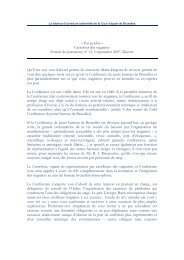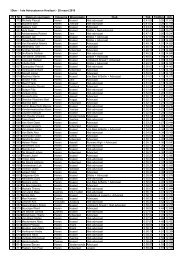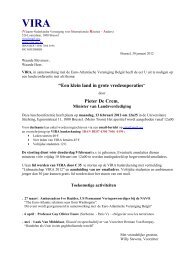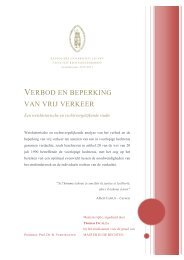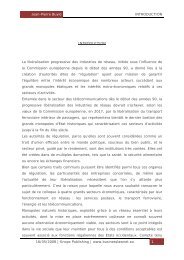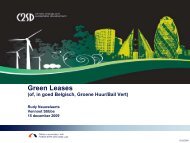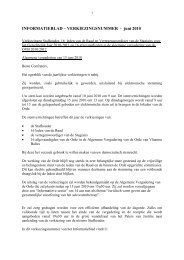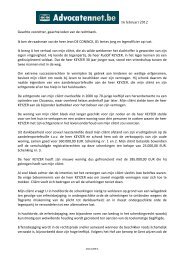ABUSE OF A DOMINANT POSITION - Advocatennet
ABUSE OF A DOMINANT POSITION - Advocatennet
ABUSE OF A DOMINANT POSITION - Advocatennet
You also want an ePaper? Increase the reach of your titles
YUMPU automatically turns print PDFs into web optimized ePapers that Google loves.
Brussels Bar, Flemish Section<br />
3rd International Competition Conference<br />
23 November 2007<br />
<strong>ABUSE</strong> <strong>OF</strong> A <strong>DOMINANT</strong> <strong>POSITION</strong><br />
- The EC case law on Art 82 EC as it stands today -<br />
Luc Gyselen<br />
Partner<br />
Arnold & Porter LLP, Brussels
Overview<br />
• Art. 82 EC: general issues<br />
– Typology of abuses<br />
– Causality between abuse and dominance<br />
– Interaction with Art. 81 EC<br />
– Remedies<br />
• Exclusionary abuses: analytical framework for assessment<br />
– Hoffmann-La Roche (1979)<br />
– Commission’s Discussion Paper (2005)<br />
– British Airways and Microsoft (2007)<br />
• Exclusionary abuses: post-Discussion Paper pricing cases<br />
– Loyalty y rebates (Tomra)<br />
– Margin squeeze (Telefonica)<br />
2
• Continental Can<br />
I. Art. 82 EC: general issues (1)<br />
- typology of abuses -<br />
– 26. “The provision is not only aimed at practices which may cause damage to<br />
consumers directly, but also at those which are detrimental to them through their<br />
impact on an effective competition structure (…). Abuse may therefore occur if<br />
an undertaking in a dominant position strengthens th such position in such a way<br />
that the degree of dominance reached substantially fetters competition, i.e. that<br />
only undertakings remain in the market whose behavior depends on the<br />
dominant one.”<br />
– Typology<br />
• Exclusionary abuses: focus on distortion of competitive process<br />
• Exploitative abuses: focus on direct customer / consumer harm<br />
3
I. Art. 82 EC: general issues (2)<br />
- Causality between abuse and dominance -<br />
• Continental Can<br />
– 27. “The question of the link of causality raised by the applicants which in their<br />
opinion has to question exist between the dominant position and its abuse, is of<br />
no consequence, for the strengthening of the position of an undertaking may be<br />
an abuse and prohibited under article 86 of the treaty, regardless of the means<br />
and procedure by which it is achieved, if it has the effects mentioned above.”<br />
– Causality<br />
• In most cases, the abuse implies the anti-competitive use of substantial market power<br />
• Other cases<br />
– Structural: e.g. Continental Can<br />
– Behavioral: e.g. AstraZeneca<br />
4
I. Art. 82 EC: general issues (3)<br />
- interaction with Art. 81 EC -<br />
• If exemption Art. 81-3 EC, no abuse under Art. 82 EC – Atlantic Container<br />
1456. “Where the Commission grants an individual exemption pursuant to Article 81(3) of<br />
the Treaty in respect of agreements notified by undertakings holding a dominant position, it<br />
indirectly bars itself, in the absence of a change in the facts or the law, from considering that<br />
the same agreements I<br />
constitute t abuses contrary to Article 82 of the Treaty”.<br />
• Simultaneous application of Art. 81 EC and Art 82 EC prohibitions - CMB<br />
33. “It is clear from the very wording of Articles 81 (a), (b), (d) and (e) and 82 (a) to (d) of the<br />
Treaty that the same practice may give rise to an infringement of both provisions.<br />
Simultaneous application of Articles 81 and 82 of the Treaty cannot therefore be ruled out a<br />
priori.”<br />
i 5
• Antitrust remedies<br />
I. Art. 82 EC: general issues (4)<br />
- remedies -<br />
– Art. 7 decisions: prohibition, cease-and-desist order, fines<br />
• fines inappropriate, except when conduct makes no economic sense but for<br />
an exclusionary strategy?<br />
– Art. 9 decisions: commitments<br />
• Cf. Coca Cola (2005), De Beers (2006) and Distrigaz i (2007)<br />
• Regulatory remedies<br />
– closure of Vodafone, O2 and T-Mobile 82 roaming cases (2007)<br />
6
II. Exclusionary abuses: analytical framework (1)<br />
- Hoffmann-La Roche -<br />
• Dominance<br />
– 38. “The dominant position (…) relates to a position of economic strength enjoyed by an<br />
undertaking which enables it to prevent effective competition being maintained on the<br />
relevant market by affording it the power to behave to an appreciable extent independently of<br />
its competitors, its customers and ultimately of the consumers.”<br />
• Abuse<br />
– 91. “The concept of abuse is an objective concept relating to the behavior of an undertaking<br />
in a dominant position which is such as to influence the structure of a market where, as a<br />
result of the very presence of the undertaking in question, the degree of competition is<br />
weakened and which, through recourse to methods different from those which condition<br />
normal competition in products or services on the basis of the transactions of commercial<br />
operators, has the effect of hindering the maintenance of the degree of competition still<br />
existing in the market or the growth of that competition.”<br />
7
II. Exclusionary abuses: analytical framework (2)<br />
- Hoffmann-La Roche -<br />
• Residual competition (“Restwettbewerb”)<br />
t ttb b”)<br />
• An in-built bias against dominance?<br />
• Methods different from those which condition normal competition<br />
(“Leistungswettbewerb”)<br />
ttb b”)<br />
• The smaller-but-equally-efficient equally efficient competitor as benchmark… but “it<br />
may sometimes be necessary in the consumers’ interest to also<br />
protect competitors that are not (yet) as efficient as the dominant<br />
company” (point 67 COM discussion paper). p 8
II. Exclusionary abuses: analytical framework (3)<br />
- Michelin I -<br />
• A dominant company’s “special responsibility”<br />
– 57. “ A finding that an undertaking has a dominant position is not in itself a recrimination but<br />
simply means that, irrespective of the reasons for which it has such a dominant position , the<br />
undertaking concerned has a special responsibility not to allow its conduct to impair genuine<br />
undistorted competition on the common market.”<br />
• Assessment a dominant company’s conduct in light of “all the<br />
circumstances”<br />
– 73. “In deciding whether Michelin abused its dominant position in applying its discount<br />
system it is therefore necessary to consider all the circumstances, particularly the criteria and<br />
rules for the grant of the discount, and to investigate whether, in providing an advantage not<br />
based on any economic service justifying it, the discount tends to remove or restrict the<br />
buyer's freedom to choose his sources of supply, to bar competitors from access to the<br />
market, to apply dissimilar conditions to equivalent transactions with other trading parties or<br />
to strengthen the dominant position by distorting competition. ”<br />
9
II. Exclusionary abuses: analytical framework (4)<br />
- Commission’s Discussion Paper -<br />
• A two-prong legality test<br />
– Foreclosure: market distorting effect (points 58-59 COM discussion paper)<br />
• Capability to foreclose (nature or form of conduct),<br />
• Incidence, i.e. market coverage of conduct, network effects<br />
• Degree of market power – very similar to Delimitis in Art. 81-1<br />
– Consumer harm: no defenses (points 77-79 COM discussion paper)<br />
• Objective justifications: objective necessity, meeting competition<br />
• Efficiencies: balancing anti-competitive and pro-competitive effects<br />
10
II. Exclusionary abuses: analytical framework (5)<br />
- Commission’s Discussion Paper -<br />
• Efficiencies: burden of proof<br />
– Art. 2 Regulation n°1/2003<br />
– but see Glaxo Wellcome<br />
• Efficiencies: standard of proof<br />
– Proportionality test (cf. § 90 discussion paper; cf. § 79COMnoticeonArt on Art. 813 81-3<br />
EC)<br />
– No substantial lessening of competition (cf. § 91 discussion paper; cf. § 105<br />
COM notice on Art. 81-3)<br />
– but see Glaxo Wellcome<br />
11
II. Exclusionary abuses: analytical framework (6)<br />
- British Airways -<br />
• Foreclosure: amalgamating “fidelity-building effect” and “exclusionary effect”<br />
– 90. “The Court of First Instance did not (…) make any error of law in holding that<br />
the bonus schemes at issue had a fidelity-building effect [and)] that they<br />
therefore produced an exclusionary effect (…)”.<br />
– 98. “ (…) The Court of First Instance was able to conclude, without committing<br />
any error of law, that the bonus schemes at issue had a fidelity-building effect. It<br />
follows that BA’s plea accusing the Court of not examining the probable effects of<br />
those schemes is unfounded.”<br />
– 145. “(…) There is nothing to prevent discrimination between business partners<br />
who are in a relationship of competition from being regarded as being abusive as<br />
soon as the behavior of the undertaking in a dominant position tends, having<br />
regard to the whole of the circumstances of the case, to lead to a distortion of<br />
competition between those business partners. In such a situation, it cannot be<br />
required in addition that proof be adduced of an actual quantifiable deterioration<br />
in the competitive position of the business partners taken individually.”<br />
12
II. Exclusionary abuses: analytical framework (7)<br />
- British Airways -<br />
• Justification<br />
– 69. “It then needs to be examined whether there is an objective economic<br />
justification for the discounts and bonuses granted. In accordance with the<br />
analysis carried out by the Court of First Instance (…), an undertaking is at liberty<br />
to demonstrate that its bonus system producing an exclusionary effect is<br />
economically justified.”<br />
– 86. “Assessment of the economic justification for a system of discounts or<br />
bonuses established by an undertaking in a dominant position is to be made on<br />
the basis of the whole of the circumstances of the case (…). It has to be<br />
determined whether the exclusionary effect arising from such a system, which is<br />
disadvantageous for competition, may be counterbalanced, or outweighed, by<br />
advantages in terms of efficiency which also benefit the consumer. If the<br />
exclusionary effect of that system bears no relation to advantages for the market<br />
and consumers, or if it goes beyond what is necessary in order to attain those<br />
advantages, that system must be regarded as an abuse.”<br />
13
II. Exclusionary abuses: analytical framework (8)<br />
- Microsoft -<br />
• Foreclosure: market distorting effect?<br />
– Refusal to deal: diluting the Magill and IMS conditions?<br />
• The degree of lessening competition<br />
• The degree of novelty of the products whose emergence is prevented<br />
– Tying: diluting the Hilti and Tetrapak conditions?<br />
• Foreclosure is not the primary issue<br />
• Foreclosure depends on behavior of third parties (content providers)<br />
14
II. Exclusionary abuses: analytical framework (9)<br />
- Microsoft -<br />
• Justifications: “special responsibility” of the dominant company<br />
– Refusal to deal: weighing the incentives for innovation (paragraphs 697 – 710)<br />
• those for Microsoft not chilled?<br />
• those for competitors taken for granted?<br />
– Tying: integrating new functionalities into existing product (paragraph 1150)<br />
• adding functionalities is fine, but tying product must also be offered on stand-alone basis, even if there<br />
is only limited demand for it.<br />
15
III. Exclusionary abuses: recent pricing cases<br />
-two post-Discussion Paper cases -<br />
• Loyalty rebates: Tomra (2006)<br />
– Fidelity-building: the so-called suction effect (challenged by Tomra)<br />
– Exclusionary effect: empirical evidence (e.g. stability of Tomra’s market share, no successful<br />
market entry, more sales during the period where more exclusionary practices were at play).<br />
• Margin squeeze: Telefonica (2007)<br />
– The benchmark: the smaller-but-equally-efficient competitor<br />
– Exclusionary effect: empirical evidence (e.g. Telefonica’s growth rates surpassing by far that<br />
of its competitors) and harm on consumers (e.g. Spanish broadband access costs 20%<br />
more than the EU-15 average.<br />
16



